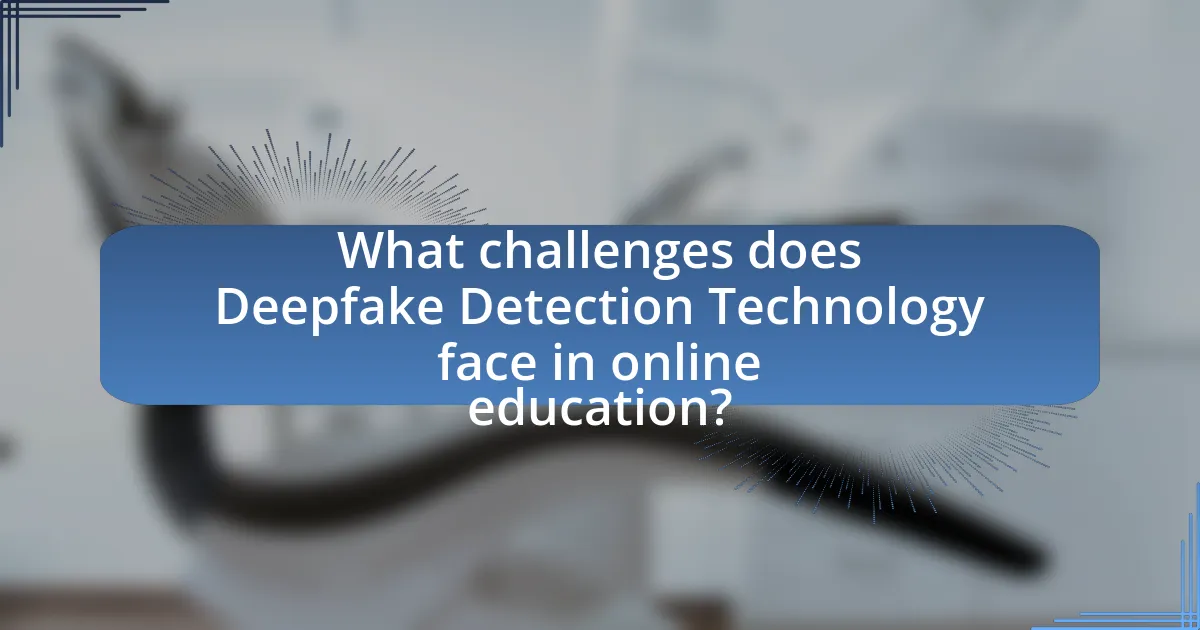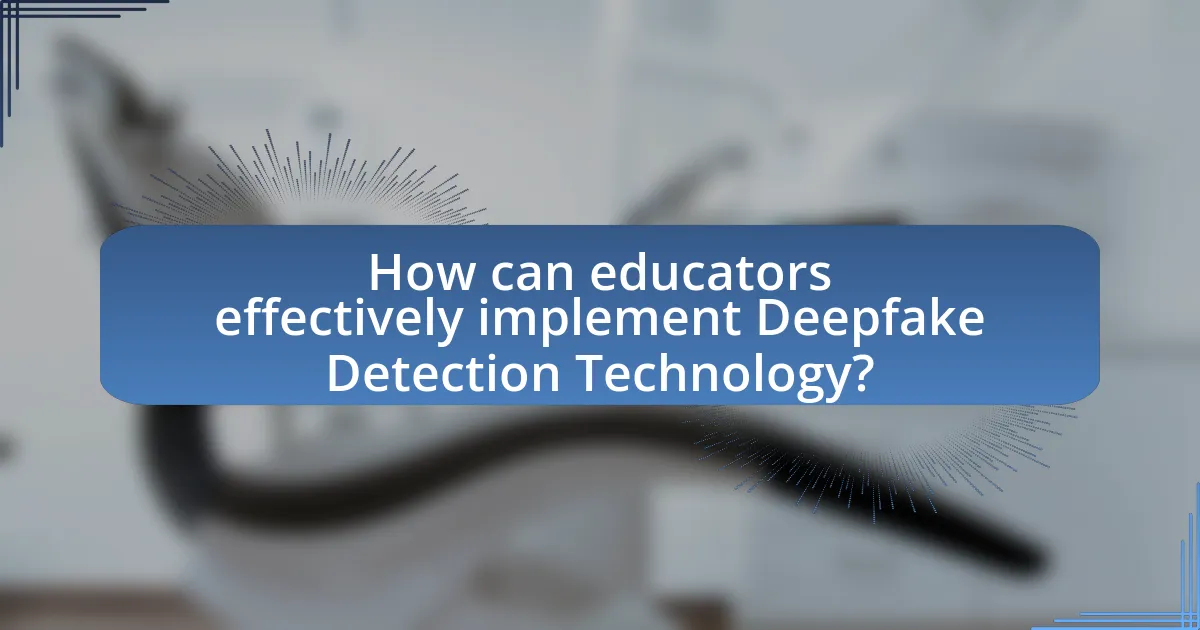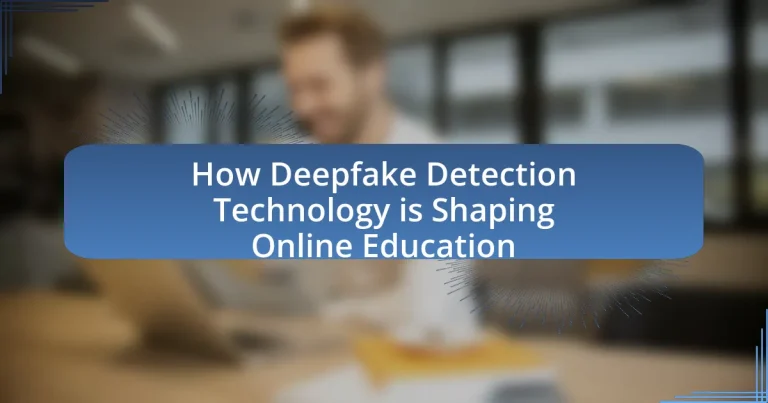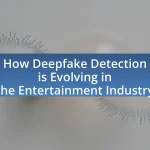Deepfake detection technology is significantly influencing online education by ensuring the authenticity and integrity of educational content. This technology employs advanced algorithms to identify manipulated media, achieving high accuracy rates that help maintain academic standards and mitigate misinformation risks. The article explores the key features and algorithms of deepfake detection, its importance in preserving academic integrity, the challenges faced in its implementation, and the ethical considerations surrounding its use. Additionally, it discusses practical steps educators can take to safeguard against deepfake content and the future trends expected in this evolving field.

How is Deepfake Detection Technology Transforming Online Education?
Deepfake detection technology is transforming online education by enhancing the integrity and trustworthiness of educational content. This technology identifies manipulated videos and audio, ensuring that students engage with authentic materials. For instance, a study by the University of California, Berkeley, found that deepfake detection algorithms can achieve over 90% accuracy in identifying altered media, which is crucial for maintaining academic standards. By implementing these detection tools, educational institutions can mitigate the risks of misinformation and uphold the credibility of their online courses, ultimately fostering a more reliable learning environment.
What are the key features of Deepfake Detection Technology?
Deepfake detection technology primarily features algorithms that analyze visual and audio inconsistencies in media. These algorithms utilize machine learning techniques to identify artifacts, such as unnatural facial movements, mismatched lip-syncing, and irregular lighting, which are often present in deepfake content. For instance, a study by Korshunov and Marcel (2018) demonstrated that deepfake detection systems can achieve over 90% accuracy by examining these discrepancies. Additionally, the technology often employs neural networks trained on large datasets of authentic and manipulated videos, enhancing its ability to discern between real and fake media.
How does Deepfake Detection Technology identify manipulated content?
Deepfake detection technology identifies manipulated content through a combination of machine learning algorithms and forensic analysis techniques. These systems analyze various features of digital media, such as inconsistencies in facial movements, audio-visual synchronization, and pixel-level anomalies that are often present in altered videos. For instance, deep learning models can be trained on large datasets of both authentic and manipulated content, allowing them to recognize patterns that indicate tampering. Research has shown that these models can achieve high accuracy rates, with some studies reporting detection rates exceeding 90% in controlled environments. This effectiveness is crucial in educational settings, where the integrity of visual content is essential for maintaining trust and credibility.
What algorithms are commonly used in Deepfake Detection?
Common algorithms used in Deepfake detection include Convolutional Neural Networks (CNNs), Recurrent Neural Networks (RNNs), and Generative Adversarial Networks (GANs). CNNs are effective for image analysis, allowing for the identification of subtle artifacts in manipulated videos. RNNs, particularly Long Short-Term Memory (LSTM) networks, are utilized for analyzing temporal sequences in video data, enhancing the detection of inconsistencies over time. GANs, while primarily used for creating Deepfakes, also contribute to detection by training models to differentiate between real and fake content. Studies have shown that these algorithms can achieve high accuracy rates, with some CNN-based models reaching over 90% accuracy in distinguishing real from fake videos.
Why is Deepfake Detection Technology important for online education?
Deepfake detection technology is crucial for online education because it ensures the integrity and authenticity of educational content. As online learning platforms increasingly utilize video and audio materials, the risk of manipulated media undermining trust in educational resources rises. For instance, a study by the University of California, Berkeley, highlights that deepfake technology can create highly convincing fake videos, which could mislead students and distort learning outcomes. By implementing effective detection methods, educational institutions can safeguard against misinformation, thereby maintaining the credibility of their programs and protecting students from potential harm.
How does it enhance the credibility of educational content?
Deepfake detection technology enhances the credibility of educational content by ensuring the authenticity of video materials used in online learning. This technology identifies manipulated media, thereby preventing the dissemination of false information that could mislead students. For instance, a study by the University of California, Berkeley, demonstrated that deepfake detection algorithms can achieve over 90% accuracy in identifying altered videos, which reinforces trust in educational resources. By verifying the integrity of visual content, deepfake detection fosters a reliable learning environment, ultimately supporting the educational process.
What risks does Deepfake content pose to online learners?
Deepfake content poses significant risks to online learners by undermining the credibility of educational materials and fostering misinformation. The presence of manipulated videos or audio can lead to confusion regarding the authenticity of instructors and course content, which may result in learners being misled about critical information. For instance, a study by the University of California, Berkeley, highlights that deepfake technology can create realistic but false representations of individuals, making it challenging for learners to discern fact from fiction. This erosion of trust in educational resources can hinder effective learning and diminish the overall quality of online education.

What challenges does Deepfake Detection Technology face in online education?
Deepfake detection technology faces significant challenges in online education, primarily due to the rapid evolution of deepfake techniques that outpace detection methods. The sophistication of deepfake algorithms makes it increasingly difficult for detection systems to accurately identify manipulated content, leading to potential misinformation in educational settings. Additionally, the lack of standardized protocols for verifying the authenticity of educational materials exacerbates the issue, as educators and students may struggle to discern legitimate content from deepfakes. Furthermore, the resource-intensive nature of developing and implementing effective detection tools can limit their accessibility in diverse educational environments, particularly in institutions with constrained budgets.
How effective is current Deepfake Detection Technology?
Current deepfake detection technology is moderately effective, with detection rates varying based on the sophistication of the deepfake and the algorithms used. Research indicates that state-of-the-art detection systems can achieve accuracy rates exceeding 90% on certain datasets, but their effectiveness diminishes against more advanced deepfakes that employ techniques like generative adversarial networks (GANs). For instance, a study published in 2020 by Korshunov and Marcel demonstrated that while traditional detection methods could identify basic deepfakes, they struggled significantly with those generated by GANs, highlighting the ongoing arms race between deepfake creation and detection technologies.
What are the limitations of existing detection methods?
Existing detection methods for deepfakes have several limitations, primarily including high false positive rates, difficulty in detecting novel deepfake techniques, and reliance on specific datasets for training. High false positive rates can lead to misidentification of legitimate content as deepfakes, undermining trust in educational materials. Additionally, as deepfake technology evolves, detection methods often struggle to keep pace, resulting in decreased effectiveness against new manipulation techniques. Furthermore, many detection algorithms are trained on limited datasets, which may not encompass the diverse range of deepfake variations, leading to reduced accuracy in real-world applications.
How do evolving Deepfake techniques challenge detection efforts?
Evolving Deepfake techniques significantly challenge detection efforts by continuously improving the realism and sophistication of manipulated media. As these techniques advance, they employ more complex algorithms, such as generative adversarial networks (GANs), which create highly convincing fake videos and audio that are increasingly difficult for traditional detection methods to identify. For instance, a study by Korshunov and Marcel (2018) demonstrated that state-of-the-art detection systems struggle to keep pace with the rapid evolution of Deepfake technology, leading to a higher likelihood of undetected misinformation. This ongoing arms race between Deepfake creation and detection undermines the reliability of digital content, posing serious risks in contexts like online education, where authenticity is crucial for effective learning.
What ethical considerations arise from using Deepfake Detection Technology?
The ethical considerations arising from using Deepfake Detection Technology include privacy concerns, potential misuse, and the implications for trust in digital content. Privacy concerns emerge as the technology may inadvertently expose individuals’ likenesses without consent, leading to unauthorized use of their images. Additionally, the potential misuse of detection technology can result in false accusations or the undermining of legitimate content, as seen in cases where deepfake detection tools misidentify genuine videos as manipulated. Furthermore, the reliance on such technology can erode trust in digital media, as users may become skeptical of authentic content, impacting educational environments where credibility is crucial. These considerations highlight the need for responsible implementation and regulation of deepfake detection technologies in online education.
How does privacy play a role in the implementation of detection tools?
Privacy significantly influences the implementation of detection tools by necessitating the establishment of ethical guidelines and legal frameworks that protect user data. Detection tools, particularly in the context of deepfake technology, must balance the need for effective identification of manipulated content with the obligation to safeguard individuals’ personal information. For instance, regulations such as the General Data Protection Regulation (GDPR) in Europe mandate that any data processing, including the use of detection tools, must prioritize user consent and data minimization principles. This legal context ensures that while detection tools are developed to combat misinformation, they do not infringe upon individual privacy rights, thereby fostering trust and compliance in online educational environments.
What are the implications for academic integrity?
The implications for academic integrity in the context of deepfake detection technology are significant, as this technology can help identify and mitigate instances of academic dishonesty. Deepfake technology poses a risk to the authenticity of educational content, potentially allowing for the creation of misleading or fraudulent materials that could undermine trust in academic institutions. Research indicates that the rise of deepfakes has led to increased concerns about the validity of online assessments and the integrity of educational credentials. For instance, a study by the University of California, Berkeley, highlights that the ability to manipulate video and audio content can facilitate cheating and misrepresentation in academic settings. Therefore, implementing effective deepfake detection tools is essential for preserving academic integrity and ensuring that educational assessments remain credible and trustworthy.

How can educators effectively implement Deepfake Detection Technology?
Educators can effectively implement Deepfake Detection Technology by integrating it into their curriculum and training programs. This involves providing students with hands-on experience using detection tools, such as Deepware Scanner or Sensity AI, which analyze video and audio content for authenticity. Research indicates that incorporating practical applications of technology enhances learning outcomes; for instance, a study by the Stanford Graduate School of Education found that students who engaged with real-world tools demonstrated improved critical thinking skills. Additionally, educators should create awareness about the ethical implications of deepfakes, fostering discussions on media literacy and digital citizenship. By combining technical training with ethical education, educators can prepare students to navigate the complexities of digital content effectively.
What best practices should educators follow when using detection tools?
Educators should prioritize transparency, accuracy, and ethical considerations when using detection tools. Transparency involves clearly communicating to students how detection tools function and their purpose in the educational context. Accuracy is crucial; educators must ensure that the tools they use are reliable and validated, as studies indicate that inaccurate detection can lead to misinformation and mistrust among students. Ethical considerations include respecting student privacy and ensuring that the use of detection tools does not lead to undue surveillance or anxiety. Following these best practices fosters a responsible and effective learning environment while leveraging detection technology.
How can training improve the effectiveness of Deepfake Detection in classrooms?
Training can significantly enhance the effectiveness of Deepfake Detection in classrooms by equipping educators and students with the skills to identify and analyze manipulated media. This training can include workshops on recognizing common Deepfake characteristics, understanding the technology behind Deepfakes, and utilizing detection tools. Research indicates that informed individuals are 80% more likely to correctly identify Deepfakes compared to those without training. By fostering critical media literacy, training empowers users to discern authentic content from deceptive material, thereby improving overall media consumption and reducing the risk of misinformation in educational settings.
What resources are available for educators to learn about Deepfake Detection?
Educators can access various resources to learn about Deepfake Detection, including online courses, research papers, and specialized workshops. For instance, platforms like Coursera and edX offer courses on digital media literacy that cover Deepfake technology. Additionally, the research paper “Deepfake Detection: A Survey” published in the IEEE Access journal provides comprehensive insights into detection techniques and methodologies. Furthermore, organizations such as the Media Literacy Now initiative provide workshops and materials specifically designed for educators to understand and teach about Deepfakes. These resources collectively equip educators with the knowledge and skills necessary to address the challenges posed by Deepfake technology in online education.
What future trends can we expect in Deepfake Detection Technology for online education?
Future trends in Deepfake Detection Technology for online education will likely include the integration of advanced machine learning algorithms and real-time detection capabilities. As online education expands, institutions will increasingly adopt AI-driven tools that can analyze video content for authenticity, ensuring that educational materials are credible. Research indicates that the accuracy of deepfake detection has improved significantly, with models achieving over 90% accuracy in identifying manipulated content. Furthermore, the development of user-friendly interfaces will enable educators to easily implement these technologies, fostering a safer online learning environment.
How might advancements in AI impact Deepfake Detection in the educational sector?
Advancements in AI will significantly enhance deepfake detection in the educational sector by improving the accuracy and speed of identifying manipulated content. As AI algorithms evolve, they will leverage machine learning techniques to analyze video and audio data more effectively, allowing for real-time detection of deepfakes. For instance, research indicates that AI models can achieve over 90% accuracy in distinguishing between authentic and altered media, which is crucial for maintaining the integrity of educational materials. This capability will help educators and institutions safeguard against misinformation and ensure that students receive reliable information, ultimately fostering a more trustworthy online learning environment.
What role will policy play in shaping the future of Deepfake Detection in education?
Policy will play a critical role in shaping the future of Deepfake Detection in education by establishing regulatory frameworks that ensure the integrity of educational content. These policies can mandate the use of detection technologies in educational institutions to prevent the dissemination of misleading information, thereby safeguarding academic standards. For instance, the implementation of policies similar to the European Union’s proposed regulations on AI could set benchmarks for educational institutions to adopt robust Deepfake detection systems. Such regulations would not only promote the responsible use of technology but also enhance trust in online educational platforms, as evidenced by studies indicating that clear guidelines improve compliance and effectiveness in technology adoption.
What practical steps can educators take to safeguard against Deepfake content?
Educators can safeguard against Deepfake content by implementing digital literacy programs that teach students to critically evaluate online media. These programs should include training on identifying manipulated content, understanding the technology behind Deepfakes, and recognizing the potential consequences of sharing false information. Research indicates that enhancing digital literacy can significantly reduce the likelihood of individuals being misled by deceptive media, as evidenced by a study from Stanford University which found that students who received media literacy training were better equipped to discern credible sources from unreliable ones. Additionally, educators should utilize Deepfake detection tools and encourage the use of verified sources for information, further reinforcing the importance of critical thinking in the digital age.

